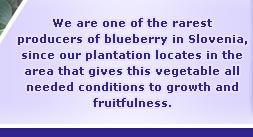 |
 |
 |
 |
 |
 |
 |
 |
 |
 |
 |
 |
|
SHORT INSTRUCTIONS for growing HEAVY FRUIT FULL blueberries |
A blueberry bush is 2 m high plant suitable for plantation and decorative gardens.
CLIMATE: Those plants successfully grow in warm and moisture climate, among 200 and 700 m height above sea level. They need at least 800 hours resting at temperature (+ 4)o C. Temperature (- 25) oC does not harm them.
FLOOR - HUMUS: The blueberry is a very complicated plant due to the humus. It demands high value of sour substance (pH 3,5 to 5,3), soft humus and average value of moisture during the vegetation season. We add the sour substance by fertilising with the psychological sour fertilisers: amonosulphate, and with mixing peat and humus, pine tree sawdust or even pine tree bark. Humus round the bush we cover with (mulch) grass, sawdust, inc.
FERTILISING: Late in the autumn, when the plant-resting (but not on the frozen floor) with NPK 10-15-20-3 Mg -1B for fruit plants and when the spring 2 to 3 times amonosulphate, each time half of fist. We fertilise at least 20 cm away from the bush. Periodically foil fertilising is recommendable but not necessarily. The last part of June we stop with fertilising of any kind, that the sprouts can harden and lignify.
PRUNING: We do the pruning in a spring when the plant is still in resting period. We leave on the plant 6 to 8 strong stables and we are keeping the bush disposed on air and light. We prune of all week, hanging, broken and ground touching branches. Branches and sprouts we never shorten.
FRUITFULNESS: The blueberry bush reaches the full fruitfulness at the age of 8 or 10 and makes the best by OPTIMAL conditions from 8 to 10 and even more kg per bush. The berries are from 8 to 22 mm thick - it depends on a sort, age and growing methods.
ADVICE: Growing a plant in a 100 litre's vessel (1/2 benzin vessel) or separating humus with PVC foil turns out like a very appropriate approach, because light peat humus does not mix with the regular garden humus. In those conditions we can keep still the low pH and if we provide appropriate value of water the success can not be avoidable.
Reference:
M.Oblak: Pridelovanje borovnic, Kmetijski inštitut Slovenije, št. 70 , Lj. 1989
Expert help: Mrs. Darinka Koron from the Agricultural Institute of Slovenia
|
|
|
|
|
 |
 |
 |
 |
|
|
|
|
|
|
|
|
|